|
Co-sponsors of the 2023 Winning Out
Certificates


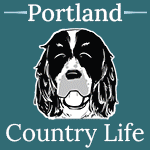
| |
Agility needs movement and
muscle...
 Dogs
generate and control
immense muscle power, ideal for agility. It enables them to create speed,
jump obstacles, balance and change direction. However, this does intensify
the stress placed on their body. That's not to say all injuries are caused
by agility, but it does increase the risk. Jenny Youdan, owner of K9
Elements and a member of the
Canine Massage Guild, explains. Dogs
generate and control
immense muscle power, ideal for agility. It enables them to create speed,
jump obstacles, balance and change direction. However, this does intensify
the stress placed on their body. That's not to say all injuries are caused
by agility, but it does increase the risk. Jenny Youdan, owner of K9
Elements and a member of the
Canine Massage Guild, explains.
Did you know that
there are nearly 700 muscles attached to 320 bones (depending on tail
length) in the dog's body. The combined function of these muscles, bones and
joints all working together create movement, whether it's walking, running
or jumping.
Human athletes
have to look after their body to maintain and improve performance, whilst increasing
longevity in their field. This includes warm-ups, cool-downs, training,
rest periods, good nutrition and hydration levels, sport massage for
muscular health and appropriate injury management. Why
should it be any different for our dogs?
Your dog
is an athlete, training and competing in a high impact sport. It is
important for owners to consider all aspects of the dog's life as they all
ultimately impact their performance.
Consider
your dog a finely tuned, well-balanced animal. If he injures just one
muscle, it can affect his entire muscular balance. However, his natural
resilience means he hides his pain, making it harder for owners to see he's
carrying an injury. Instead, he will overcompensate for the injury, placing
further stress on other muscles, creating a potential ever-increasing spiral
of injuries.
Muscular injuries
To
understand muscular injuries, you firstly need to consider
what is a healthy muscle? It is
smooth, supple and flexible. All layers of muscle can slide and glide over
each other easily, to allow the body to move fully. An injury is something
that prevents or restricts this movement.
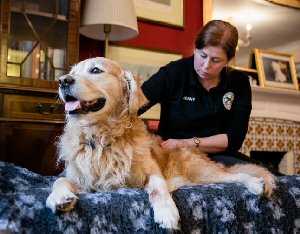 There
is
a variety of muscular injuries. There
is
a variety of muscular injuries.
-
Strains
are one of the most common injuries.
A
pull to the muscle which occurs when stretched beyond its normal
limits, causing a tear to the muscle fibres. Strains are quite
often trivialised as just as a strain'. However, the resulting
scar tissue can reduce a muscle's flexibility by up to 50%, so
whilst it may sound minor, it can have a major impact. Clinical Canine Massage Therapy remodels the scar tissue to improve muscle
flexibility.
-
Hypertonicity
is an extremely tight muscle.
Many people assume a well-muscled dog, with strong defined muscles
is more powerful and very fit. However, in the majority of cases,
this has been confused with a hypertonic muscle. A rock solid
muscle is not fit and healthy. In fact it is a sign that it has
been over-used and remained in a shortened, contracted state. There
is no softness or suppleness and ultimately is more prone to
injury.
Clinical Canine Massage is extremely effective in reducing hypertonicity.
-
Trigger Points are a taut band within the muscle fibres.
Not only do they cause local and referred pain, but in their worst
form can cause ischemia, which deprives tissues of oxygen and
nutrients. They can restricts a dog's range of motion and also
cause the muscle to tire more quickly.
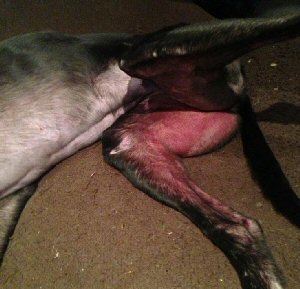 Strains Strains
This,
for instance, is Nell the Greyhound. Here, she has experienced a severe strain,
with swelling and bruising. Not all strains appear this clearly,
especially on those dogs with lots of fur covering the legs, but it
clearly demonstrates how serious can actually be.
Whilst people are familiar with muscular cramps, acute pain during or
immediately after exercise, it is worth being aware that dogs can also
experience Delayed Onset Muscle Soreness (DOMS). This is seen as pain,
soreness, tenderness or stiffness but occurs several hours or days after
strenuous or new exercise.
Is
your dog holding an injury?
Don't be fooled, just because your dog is 'fit' does not mean he is injury
free!
Owners may develop their dog's cardiovascular fitness levels and focus on
training, assuming injuries are more likely to occur from trauma or impact.
However, a lack of rest and recovery time can contribute to the risk of
potential muscular injury.
Dogs
can accumulate muscular tension and suffer injuries caused by daily
activities or sports like agility, just like humans. Whilst dogs are great
at hiding injuries and soldier on regardless, please be aware that the
muscular pain can be debilitating. By the time dogs are displaying signs of
lameness, they are normally in a reasonable degree of pain.
Signs of a potential muscular injury
As
an owner you can look for signs and changes in your dog that indicates a
possible muscular injury.
Some
obvious symptoms include:-
- Pain response yelping, discomfort,
reluctance to be touched
- Mobility problems lameness, limping, not
fully weight-bearing or stiffness
- Physical issues slowing
down, reluctant to go for walks, change in muscle tone
- Everyday obstacles
difficulty going up and down stairs, getting on and off the sofa, jumping in
and out of the car
- People often describe
their dog as 'seems old before their time' or has 'aged overnight'
 Some lesser known signals
might
include:- Some lesser known signals
might
include:-
- Change in behaviour or
personality, appearing depressed
- Posture irregularities
roaching or swayback
- Gait irregularities
crabbing or single-tracking
- Twitching down their
back, quivering skin or coat flicks.
-
Tickly spot
-
Issues with sporting
performance
For example, my own dog's
coat changes from smooth and straight to wavy in his lumbar region when
strained.
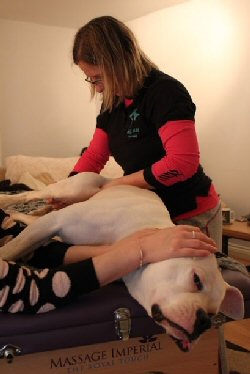 Case
study Case
study
Tali is
an American Bulldog, a gentle giant with a wonderful nature, who was four years old when Jennifer Coates of
Dogstar
Therapy first met her. Tali 's enthusiasm for agility had dropped and her owner Laura was concerned about the
strain of doing agility on Tali's joints. Laura wanted to check that Tali wasn't
harbouring an injury that was making her uncomfortable.
Jennifer found that Tali had
a strain in her iliocostalis in the lumbar region and persistent trigger points
(knots) bilaterally in her latissimus dorsi. These are common issues for agility
dogs. Laura was a brilliant owner. Tali was rested to allow the strain
to repair. Rugs were strategically placed around the house to stop Tali slipping
and Laura was fastidious in warming Tali up before all agility work.
After
three massage treatments and a staged return to training, Tali was successfully
working with her usual levels of enthusiasm and she competed later in the year
at Discover Dogs where she was placed 5th.
Agility performance
A change in your dog's
agility performance may not necessarily be a training issue. It can be
indicative of a potential muscular injury and he is avoiding the obstacle to
prevent the pain.
You may see your dog:-
- Knocking poles
- Missing contacts
- Refusing weaves or
leaving mid-way through
- Change in jumping style,
measuring or going under jumps
- Jumping off equipment
- Sudden loss of interest,
refusal or slowed down considerably
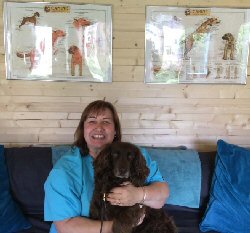 Case
study Case
study
In October 2014 Lily stopped
jumping and wouldn't put full weight through her right back leg. Her
vet prescribed pain killing drugs and referred Lily to Emma Overend
of Paw Dimensions for treatment. Lilly had strains or muscular tears
in the muscles used for jumping and for propulsion forward, namely
her Gracilis Muscle, along with pain in her sacral area of the spine
and trigger points throughout the muscles supporting her spine (her Longissimus Dorsi, Multifidus and Iliocostalis Lumborum) which were
causing her pain and restricting her movement. These are fairly
common issues found in working dogs, and it's the niche job of the
masseuse to be able to locate these.
Lily had three massage
sessions with Emma who put together a recovery and
reconditioning programme. Lily gradually returned to training and
was spotted at Crufts with her handler Julia Durrant. They were chosen for Agility Team GB in May 2015
where she was placed 33rd overall out of 187
Medium dogs from all over the world. Her speed was recorded at 4.3
meters per second!
Lily went from being
completely lame to representing Great Britain in Agility and her
owner Anne Hamilton puts it all down to the rehabilitative effects
of massage. Without it, Lily might not have made it back to Agility
for a long time - if at all - but with Emma's treatment and help she
made a speedy recovery, so much so that she qualified for Agility
Team GB 2015. Hurray!
Massage Therapy
Whilst no one wants their
dog in pain, Clinical Canine Massage Therapy can
help. It is a natural therapy
that uses specific, measured strokes to manipulate soft tissue. Please note
that the Canine Massage Guild provides remedial or clinical treatments, more
akin to human sports massage. It is definitely NOT a pampering massage!
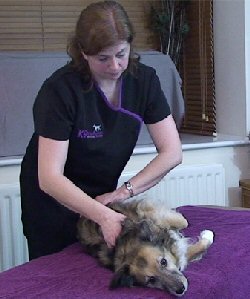 This
non-invasive treatment works primarily on the skin and muscles, but it also
influences all of the dog's physiological systems. Consequently, it provides
numerous benefits, including: This
non-invasive treatment works primarily on the skin and muscles, but it also
influences all of the dog's physiological systems. Consequently, it provides
numerous benefits, including:
- Improves mobility
- Reduces lameness
- Restores muscular balance
- Drug-free pain relief
- Supports dogs suffering
with orthopaedic conditions
Specifically for agility
dogs, it can:-
- Resolve muscular injuries
so your dog can complete all obstacles
- Improve muscle
flexibility
- Improve performance
- Increase speed over the
course
- Enable your dog to jump
freely
- Minimise the risk of
injuries (warm-ups)
- Promote quicker recovery
times (cool-downs)
- Reduce muscle stiffness
Canine
Massage Guild
The Canine
Massage Guild is a national network of
therapists, promoting safe practice, high standards and continuing
professional development. The Guild therapists are trained to locate and release the fascial
network
(body's 3D cobweb). They all have to achieve exacting standards before they become members. This means you can be confident that any Guild Therapist will provide you
and your dog with the highest level of service. The Guild Therapists work
with a wide variety of breeds enjoying agility at all levels, whether it's a pet
dog having some extra fun or top competitors.
Not only are Guild
Therapists qualified, professional and fully insured, they have:-
Expert Techniques
Advanced palpation and
injury identification skills to assess the muscles, locate and identify
the injury and specify the muscle affected.
- Progressive Canine
Massage Techniques for injury treatment. Trained in 4 disciplines
(Swedish, Deep Tissue, Sports and Myofascial Release), these are reviewed
and enhanced annually.
- Injury rehabilitation
the wide variety of massage techniques at their disposal means they can work
with various injuries and find one that suits your dog. They can also
advise on how to get your dog agility fit post-injury.
Knowledgeable
- Canine anatomy and
physiology Detailed understanding of how treatments affects the dog's body
and what is required for dogs to achieve different movements and the demands
from various sports including agility.
- Orthopaedic conditions
Therapists appreciate a wide variety of orthopaedic conditions and the
associated impact on the body.
- Other complementary
therapies As powerful as Canine Massage Therapy is, if it is not suitable
for your dog, the Guild Therapists will help you find an alternative.
- Canine sports and
activities Understands the demands various sports places on the dog's
body
Integrity
- Complies with UK law
- Refers back to your vet
for diagnosis, if an underlying condition is suspected or anything abnormal
is identified
- Mindful of
contraindications to massage therapy
- Adheres to best practice,
by only treating your dog a maximum of three times initially
- Suggests alternative
therapies and products that may benefit your dog
 Case
study Case
study
When Jack, an 8 year old
Patterdale, went for his first treatment with
Vreli Middleton of K9 Body Works he was screaming out in
pain. After one treatment there was no more screaming and he was a much more
relaxed dog. He had two further treatments and, at his next agility show, he won
all three classes. A fantastic result!
Top tips for agility dog
owners
-
Warm-up your dog before
training and competition, to reduce the risk of injury
- Know the signs of a
potential muscular injury. You know your dog best, so are more likely to
spot any changes
- Consider all aspects of
your dog's life nutrition, hydration, rest and exercise
- Regular health checks
Guild Therapists offer muscular health checks at various shows across the
country which provides a quick overview
- Find your nearest
Therapist a full treatment allows potential deeper injuries to be located
and treated, whilst improving your dog's movement
Booking your dog a
treatment with a Guild Therapist provides results you can see and your dog
can feel.
.
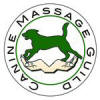
Canine Massage Guild is a national network of Therapists,
promoting safe practice, high standards and continuing professional
development.
Booking your dog a treatment with a Guild Therapist provides results you can
see and your dog can feel.
For more information
about the Canine Massage Guild or to find your nearest Therapist, please
visit their
web site
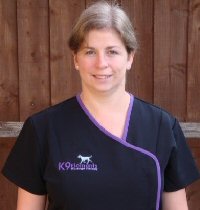 About
the author... About
the author...
Jenny Youdan, is a professional Clinical Canine Massage Therapist. She
runs K9 Elements Massage Therapy,
providing remedial massage to resolve muscular injuries, support dogs
suffering with orthopaedic conditions and maintain sporting performance.
1.
| |
|